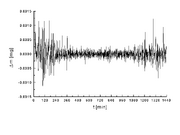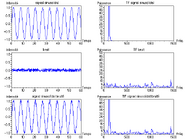Assessment |
Biopsychology |
Comparative |
Cognitive |
Developmental |
Language |
Individual differences |
Personality |
Philosophy |
Social |
Methods |
Statistics |
Clinical |
Educational |
Industrial |
Professional items |
World psychology |
Cognitive Psychology: Attention · Decision making · Learning · Judgement · Memory · Motivation · Perception · Reasoning · Thinking - Cognitive processes Cognition - Outline Index
Signal-to-noise ratio (often abbreviated SNR or S/N) is an electrical engineering concept defined as the ratio of a signal power to the noise power corrupting the signal.
In less technical terms, signal-to-noise ratio compares the level of a desired signal (such as music) to the level of background noise. The higher the ratio, the less obtrusive the background noise is.
Technical sense
Signal-to-noise ratio is an engineering term for the power ratio between a signal (meaningful information) and the background noise:
where P is average power and A is RMS amplitude. Both signal and noise power (or amplitude) must be measured at the same or equivalent points in a system, and within the same system bandwidth.
Because many signals have a very wide dynamic range, SNRs are usually expressed in terms of the logarithmic decibel scale. In decibels, the SNR is, by definition, 10 times the logarithm of the power ratio. If the signal and the noise is measured across the same impedance then the SNR can be obtained by calculating 20 times the base-10 logarithm of the amplitude ratio:
Electrical SNR and acoustics
Often the signals being compared are electromagnetic in nature, though it is also possible to apply the term to sound stimuli. Due to the definition of decibel, the SNR gives the same result independent of the type of signal which is evaluated (such as power, current, or voltage).
Signal-to-noise ratio is closely related to the concept of dynamic range, where dynamic range measures the ratio between noise and the greatest un-distorted signal on a channel. SNR measures the ratio between noise and an arbitrary signal on the channel, not necessarily the most powerful signal possible. Because of this, measuring signal-to-noise ratios requires the selection of a representative or reference signal. In audio engineering, this reference signal is usually a sine wave, sounding a tone, at a recognized and standardized nominal level or alignment level, such as 1 kHz at +4 dBu (1.228 VRMS).
SNR is usually taken to indicate an average signal-to-noise ratio, as it is possible that (near) instantaneous signal-to-noise ratios will be considerably different. The concept can be understood as normalizing the noise level to 1 (0 dB) and measuring how far the signal 'stands out'. In general, higher signal to noise is better; the signal is 'cleaner'.
Image processing and interferometry
In image processing, the SNR of an image is usually defined as the ratio of the mean pixel value to the standard deviation of the pixel values. Related measures are the "contrast ratio" and the "contrast-to-noise ratio".
The connection between optical power and voltage in an imaging system is linear. This usually means that the SNR of the electrical signal is calculated by the 10 log rule. With an interferometric system, however, where interest lies in the signal from one arm only, the field of the electromagnetic wave is proportional to the voltage (assuming that the intensity in the second, the reference arm is constant). Therefore the optical power of the measurement arm is directly proportional to the electrical power and electrical signals from optical interferometry are following the 20 log rule.
For a measurement device generally speaking

Recording of the noise of a thermogravimetric analysis device that is poorly isolated in a mechanical point of view; the middle of the curve shows a lower noise, due to a lesser surrounding human activity at night.
Any measurement device is disturbed by parasitic phenomena. This includes the electronic noise as described above, but also any external event that affects the measured phenomenon — wind, vibrations, gravitational attraction of the moon, variations of temperature, variations of humidity etc. depending on what is measured and of the sensitivity of the device.
It is often possible to reduce the noise by controlling the environment. Otherwise, when the characteristics of the noise are known and are different from the signal's, it is possible to filter it or to process the signal.
When the noise is a random perturbation and the signal is a constant value, it is possible to enhance the SNR by increasing the measurement time.
If we process a Fourier transform on the recorded signal, random noise corresponds to high frequencies: there are variations between two neighbouring points. If the signal is made of broad peaks, then these peaks correspond to low frequencies; the "highest frequency" can be estimated by inverse of the width of the peak.
Digital signals
When using digital storage the number of bits of each value determines the maximum signal-to-noise ratio. In this case the noise is the error signal caused by the quantization of the signal, taking place in the analog-to-digital conversion. The noise level is non-linear and signal-dependent; different calculations exist for different signal models. The noise is modeled as an analog error signal being summed with the signal before quantization ("additive noise").
The modulation error ratio (MER) is a measure of the SNR in a digitally modulated signal. Like SNR, MER can be expressed in dB.
Fixed point
- See also: Fixed point
For n-bit integers with equal distance between quantization levels (uniform quantization) the dynamic range (DR) is also determined.
Assuming a uniform distribution of input signal values, the quantization noise is a uniformly-distributed random signal with a peak-to-peak amplitude of one quantization level, making the amplitude ratio 2n/1. The formula is then:
This relationship is the origin of statements like "16-bit audio has a dynamic range of 96 dB". Each extra quantization bit increases the dynamic range by roughly 6 dB. Assuming a full-scale sine wave signal, the quantization noise approximates a sawtooth wave with peak-to-peak amplitude of one quantization level.[1] In this case, the SNR is:
Floating point
Floating-point numbers provide a way to trade off signal-to-noise ratio for an increase in dynamic range. For n bit floating-point numbers, with n-m bits in the mantissa and m bits in the exponent:
Note that the dynamic range is much larger than fixed-point, but at a cost of a worse signal-to-noise ratio. This makes floating-point preferable in situations where the dynamic range is large or unpredictable. Fixed-point's simpler implementations can be used with no signal quality disadvantage in systems where dynamic range is less than 6.02m. The very large dynamic range of floating-point can be a disadvantage, since it requires more forethought in designing algorithms.[2]
Notes
- Analog-to-digital converters have other sources of noise that decrease the SNR compared to the theoretical maximum from the idealized quantization noise.
- Often special filters are used to weight the noise: DIN-A, DIN-B, DIN-C, DIN-D, CCIR-601, and special filters in video - comb filter.
- Maximum possible full scale signal can be charged as peak-to-peak or as RMS. Audio uses RMS, Video P-P, which gave +9 dB more SNR for video.
- It is more common to express SNR in digital systems using Eb/No - the energy per bit per noise power spectral density.
- Further information: Quantization noise, Bit resolution
Informal use
Informally, "signal-to-noise ratio" refers to the ratio of useful information to false or irrelevant data.
In online discussion forums such as Usenet, off-topic posts and spam are regarded as "noise" that interferes with the "signal" of appropriate discussion. Another example is Bugzilla, where "please fix this" comments clutter up the discussion without helping to solve the bug.[1] A system of moderation may improve the SNR by filtering out irrelevant posts.
The wiki collaboration model addresses the same problem in a different way, by permitting users to "moderate" content, ideally adding signal while removing noise. Unfortunately, the inverse often occurs when some users add noise and remove signals from articles.[How to reference and link to summary or text]
See also
- Audio system measurements
- Video quality
- Subjective video quality
- Near-far problem
- Peak signal-to-noise ratio
- SINAD (ratio of signal-including-noise-and-distortion to noise-and-distortion only)
- ENOB
- Eb/N0
- Carrier to Noise Ratio
- Carrier-to-receiver noise density
- Contrast to Noise Ratio
- Signal detection
- SQNR (Signal-to-Quantization Noise Ratio)
- Total harmonic distortion
References
- ↑ Defining and Testing Dynamic Parameters in High-Speed ADCs — Maxim IC Application note 728
- ↑ Fixed-Point vs. Floating-Point DSP for Superior Audio — Rane Corporation technical library
External links
- ADC and DAC Glossary - Maxim IC
- Understand SINAD, ENOB, SNR, THD, THD + N, and SFDR so you don't get lost in the noise floor - Analog Devices
- The Relationship of dynamic range to data word size in digital audio processing
- Calculation of signal-to-noise ratio, noise voltage, and noise level
- Learning by simulations - a simulation showing the improvement of the SNR by time averaging
- Dynamic Performance Testing of Digital Audio D/A Converters
| This page uses Creative Commons Licensed content from Wikipedia (view authors). |









